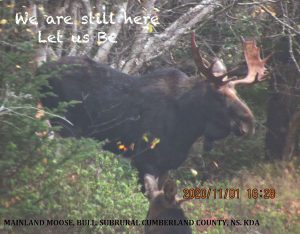NatureNS’s endorsement of the plan is significant as Nature NS has been highly critical of L&F’s management of the Mainland Moose and was one of three naturalist groups that took the province to court over this issue in 2019 – and won. NatureNS has a few reservations, particularly ones related the the Special Management Practices, and I and others are concerned that the Chebucto Peninsula was excluded from the Core Habitat areas.
On Nov 26, 2021, NS Dept of Natural Resources and Renewable (NRR or NSNRR) released the its Mainland Moose Recovery Plan following “delays, lawsuits and auditor general reports on the issue” (CBC, Nov 26, 2021).
I have read the plan in detail and find that overall, the plan is highly commendable for the detail and quality of the content.
The plan is supported with a few reservations by Nature Nova Scotia (NatureNS – view extracts from NatureNS comments on this website.
This endorsement is significant as NatureNS, led by President Bob Bancroft, has been highly critical of DNR/L&F efforts or lack of efforts to follow through on its commitments to protect and nurture the Mainland Moose. NatureNS was one of three naturalist groups that took the province to court over this issue in 2019 – and won.
Says NatureNS now:
Earlier this month, the province released the 9 years-overdue updated Recovery Plan for the Mainland Moose. Nature Nova Scotia commends the province for finally producing a sound plan and, in particular, for emphasizing the immediate need for additional research and changes to forestry practices in moose habitat. Now, we must hold the Nova Scotia government to this plan. Help us Save The Mainland Moose by taking the following actions, today:
Send a Message below – Demand the Minister of Natural Resources and Renewables designate Core Habitat for the Mainland Moose
Get a Lawn Sign – Show your support for ecological forestry by putting up one of our lawn signs. Order yours today, available for pick-up in locations across the province. Go a step further and help us fundraise for vital moose research by donating when you order your sign.
Sign our petition – demand Ecological Forestry Now.
So, Please do as NatureNS asks and support this plan!
The reservations about the Recovery plan cited by NatureNS relate primarily to Special Management Practices (SMP):
- For one, the Mainland Moose SMP doesn’t cite any of the studies or data that supposedly inform its recommendations
- Moose “shelter”, “retention”, and “buffer” patches likely need to be larger and more closely connected than the current minimum recommended
- Forest type and configuration vary widely in working landscapes, and the SMP provides few alternatives for when the ideal recommendation is simply not possible
- Road development is not currently regulated in any meaningful way, the SMP only asking that forest managers “avoid” it.
An additional reservation in my and others’ perspectives is the exclusion of the Chebucto Peninsula from the Core Habitat areas defined in the 2021 Mainland Moose Recovery Plan
Read about that here.
But like NatureNS, overall, I am pleased to see this plan and strongly support it. I will nonetheless request that the Recovery Team address the reservations expressed by Nature NS, and my and many others’ reservations about the exclusion of the Chebucto Peninsula from the Core Habitat areas.

Sign at the Last Hope Wildlife Corridor Encampment
And while the plan is highly laudable, it is for now, just a plan and not the first one.
Nova Scotians will need to remain vigilant and active to ensure that NRR doesn’t repeat the kinds of delays that have been involved in implementing the Lahey Recommendations.
Approaching 4 years after Prof Lahey tabled his report, there has been little change on the ground. The good will that followed Lahey’s report, recognizing that it involved compromises for everyone, has largely vanished. It was virtually extinguished by the successful campaign of ForestNS and allies to gut the Biodiversity Act.
As a result, also because of the immediacy of the linked climate and biodiversity crises, the status quo is no longer socially acceptable as an interim measure to allow L&F/NRR and Big Forestry to adjust to progressive change.

